A Critical Analysis: Leadership, Motivation, and Influence in Teams
VerifiedAdded on 2023/06/14
|15
|3673
|369
Essay
AI Summary
This essay presents a critical analysis of leadership, examining the role of leadership in motivating subordinates and the influence leaders exert. It questions the methodologies used in existing research, particularly the potential for bias in non-random surveys, and advocates for further investigation to uncover the complexities of leadership dynamics. The analysis explores different leadership styles, such as transactional, charismatic, and transformational leadership, and their effects on worker behavior and motivation. The author evaluates the clarity of the project undertaken, the value stance adopted, and the consistency of claims made, while also assessing the adequacy of theoretical orientations and the transparency of sources used to support the arguments. The essay concludes by emphasizing the need for a more comprehensive evaluation of leaders, considering factors beyond motivational qualities to gain a more complete understanding of effective leadership.
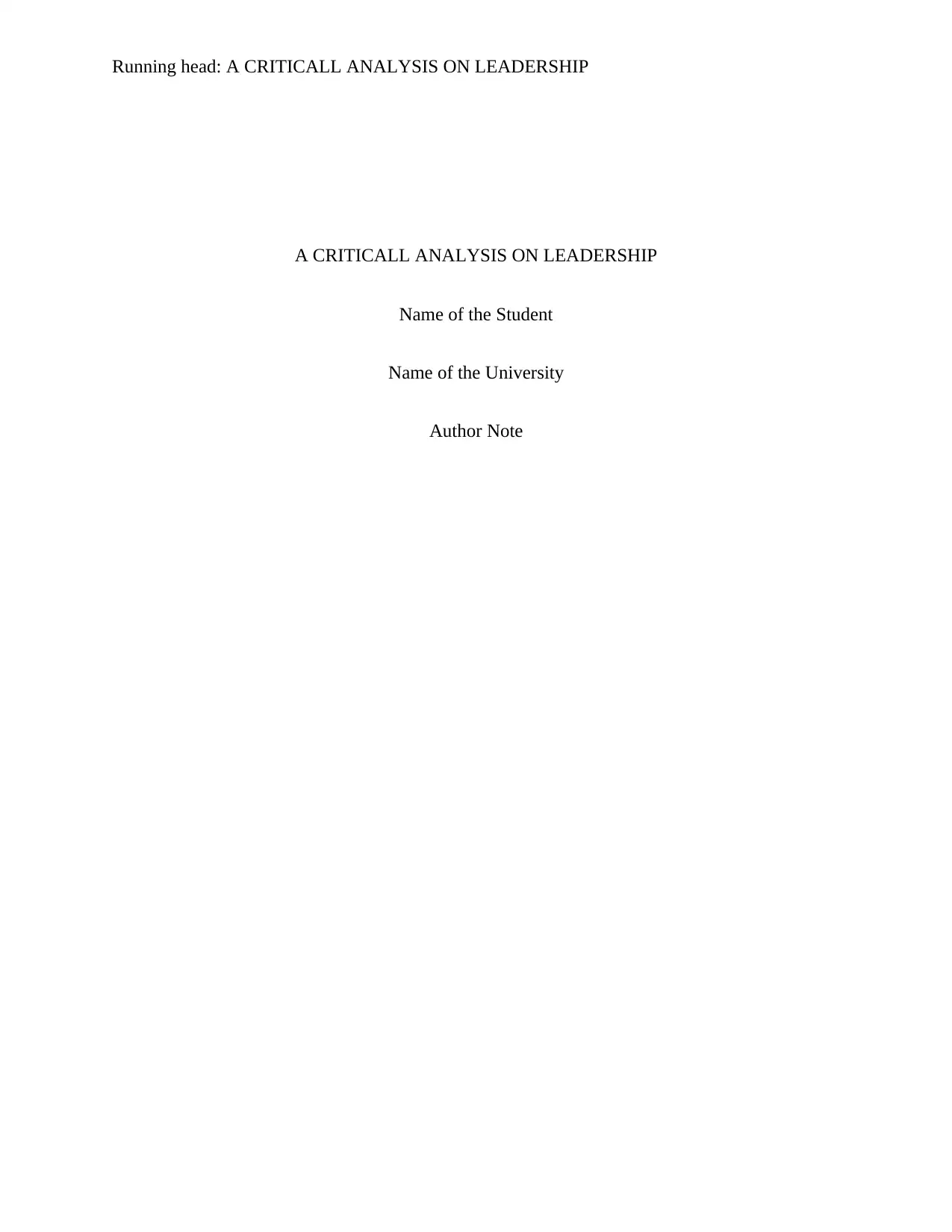
Running head: A CRITICALL ANALYSIS ON LEADERSHIP
A CRITICALL ANALYSIS ON LEADERSHIP
Name of the Student
Name of the University
Author Note
A CRITICALL ANALYSIS ON LEADERSHIP
Name of the Student
Name of the University
Author Note
Paraphrase This Document
Need a fresh take? Get an instant paraphrase of this document with our AI Paraphraser
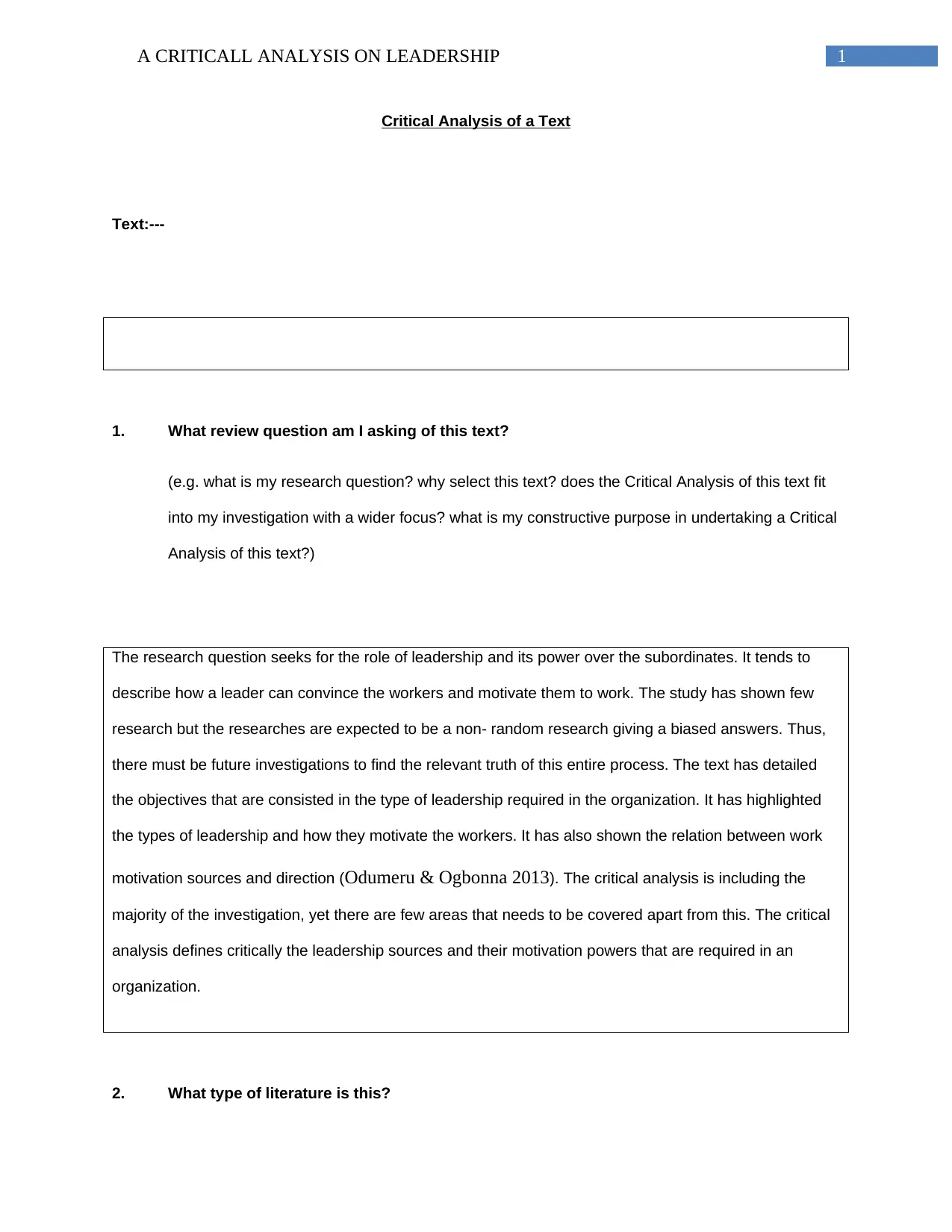
1A CRITICALL ANALYSIS ON LEADERSHIP
Critical Analysis of a Text
Text:---
1. What review question am I asking of this text?
(e.g. what is my research question? why select this text? does the Critical Analysis of this text fit
into my investigation with a wider focus? what is my constructive purpose in undertaking a Critical
Analysis of this text?)
The research question seeks for the role of leadership and its power over the subordinates. It tends to
describe how a leader can convince the workers and motivate them to work. The study has shown few
research but the researches are expected to be a non- random research giving a biased answers. Thus,
there must be future investigations to find the relevant truth of this entire process. The text has detailed
the objectives that are consisted in the type of leadership required in the organization. It has highlighted
the types of leadership and how they motivate the workers. It has also shown the relation between work
motivation sources and direction (Odumeru & Ogbonna 2013). The critical analysis is including the
majority of the investigation, yet there are few areas that needs to be covered apart from this. The critical
analysis defines critically the leadership sources and their motivation powers that are required in an
organization.
2. What type of literature is this?
Critical Analysis of a Text
Text:---
1. What review question am I asking of this text?
(e.g. what is my research question? why select this text? does the Critical Analysis of this text fit
into my investigation with a wider focus? what is my constructive purpose in undertaking a Critical
Analysis of this text?)
The research question seeks for the role of leadership and its power over the subordinates. It tends to
describe how a leader can convince the workers and motivate them to work. The study has shown few
research but the researches are expected to be a non- random research giving a biased answers. Thus,
there must be future investigations to find the relevant truth of this entire process. The text has detailed
the objectives that are consisted in the type of leadership required in the organization. It has highlighted
the types of leadership and how they motivate the workers. It has also shown the relation between work
motivation sources and direction (Odumeru & Ogbonna 2013). The critical analysis is including the
majority of the investigation, yet there are few areas that needs to be covered apart from this. The critical
analysis defines critically the leadership sources and their motivation powers that are required in an
organization.
2. What type of literature is this?
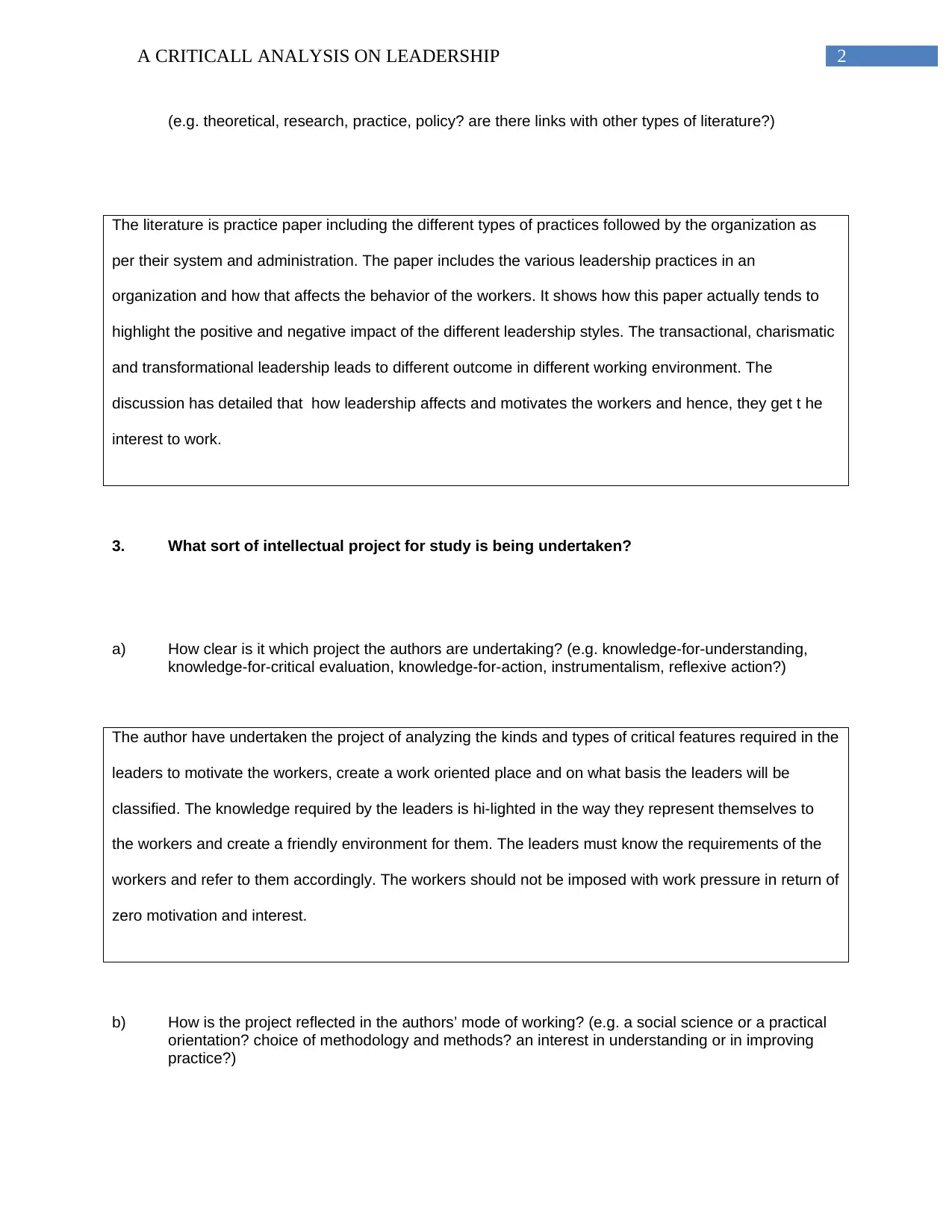
2A CRITICALL ANALYSIS ON LEADERSHIP
(e.g. theoretical, research, practice, policy? are there links with other types of literature?)
The literature is practice paper including the different types of practices followed by the organization as
per their system and administration. The paper includes the various leadership practices in an
organization and how that affects the behavior of the workers. It shows how this paper actually tends to
highlight the positive and negative impact of the different leadership styles. The transactional, charismatic
and transformational leadership leads to different outcome in different working environment. The
discussion has detailed that how leadership affects and motivates the workers and hence, they get t he
interest to work.
3. What sort of intellectual project for study is being undertaken?
a) How clear is it which project the authors are undertaking? (e.g. knowledge-for-understanding,
knowledge-for-critical evaluation, knowledge-for-action, instrumentalism, reflexive action?)
The author have undertaken the project of analyzing the kinds and types of critical features required in the
leaders to motivate the workers, create a work oriented place and on what basis the leaders will be
classified. The knowledge required by the leaders is hi-lighted in the way they represent themselves to
the workers and create a friendly environment for them. The leaders must know the requirements of the
workers and refer to them accordingly. The workers should not be imposed with work pressure in return of
zero motivation and interest.
b) How is the project reflected in the authors’ mode of working? (e.g. a social science or a practical
orientation? choice of methodology and methods? an interest in understanding or in improving
practice?)
(e.g. theoretical, research, practice, policy? are there links with other types of literature?)
The literature is practice paper including the different types of practices followed by the organization as
per their system and administration. The paper includes the various leadership practices in an
organization and how that affects the behavior of the workers. It shows how this paper actually tends to
highlight the positive and negative impact of the different leadership styles. The transactional, charismatic
and transformational leadership leads to different outcome in different working environment. The
discussion has detailed that how leadership affects and motivates the workers and hence, they get t he
interest to work.
3. What sort of intellectual project for study is being undertaken?
a) How clear is it which project the authors are undertaking? (e.g. knowledge-for-understanding,
knowledge-for-critical evaluation, knowledge-for-action, instrumentalism, reflexive action?)
The author have undertaken the project of analyzing the kinds and types of critical features required in the
leaders to motivate the workers, create a work oriented place and on what basis the leaders will be
classified. The knowledge required by the leaders is hi-lighted in the way they represent themselves to
the workers and create a friendly environment for them. The leaders must know the requirements of the
workers and refer to them accordingly. The workers should not be imposed with work pressure in return of
zero motivation and interest.
b) How is the project reflected in the authors’ mode of working? (e.g. a social science or a practical
orientation? choice of methodology and methods? an interest in understanding or in improving
practice?)
⊘ This is a preview!⊘
Do you want full access?
Subscribe today to unlock all pages.

Trusted by 1+ million students worldwide
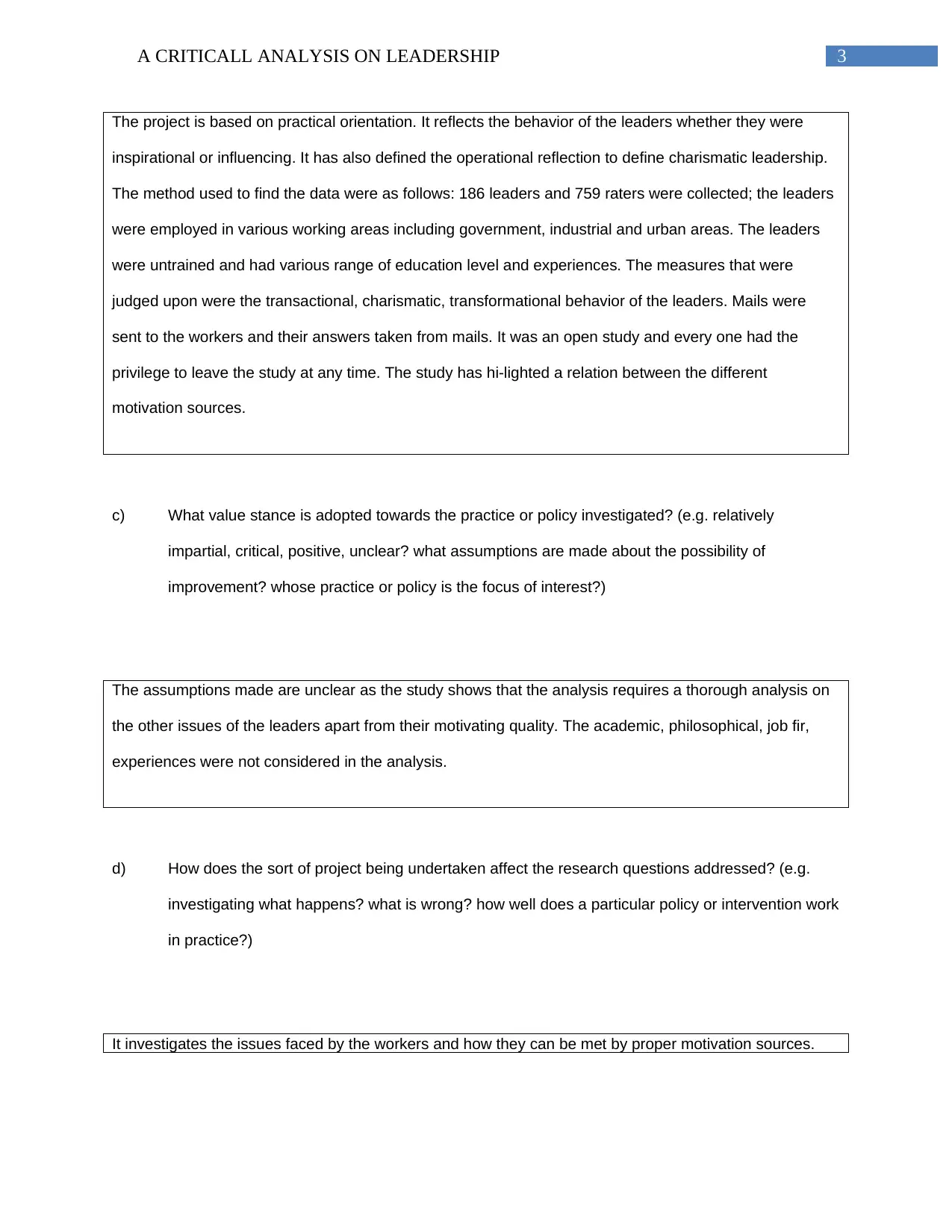
3A CRITICALL ANALYSIS ON LEADERSHIP
The project is based on practical orientation. It reflects the behavior of the leaders whether they were
inspirational or influencing. It has also defined the operational reflection to define charismatic leadership.
The method used to find the data were as follows: 186 leaders and 759 raters were collected; the leaders
were employed in various working areas including government, industrial and urban areas. The leaders
were untrained and had various range of education level and experiences. The measures that were
judged upon were the transactional, charismatic, transformational behavior of the leaders. Mails were
sent to the workers and their answers taken from mails. It was an open study and every one had the
privilege to leave the study at any time. The study has hi-lighted a relation between the different
motivation sources.
c) What value stance is adopted towards the practice or policy investigated? (e.g. relatively
impartial, critical, positive, unclear? what assumptions are made about the possibility of
improvement? whose practice or policy is the focus of interest?)
The assumptions made are unclear as the study shows that the analysis requires a thorough analysis on
the other issues of the leaders apart from their motivating quality. The academic, philosophical, job fir,
experiences were not considered in the analysis.
d) How does the sort of project being undertaken affect the research questions addressed? (e.g.
investigating what happens? what is wrong? how well does a particular policy or intervention work
in practice?)
It investigates the issues faced by the workers and how they can be met by proper motivation sources.
The project is based on practical orientation. It reflects the behavior of the leaders whether they were
inspirational or influencing. It has also defined the operational reflection to define charismatic leadership.
The method used to find the data were as follows: 186 leaders and 759 raters were collected; the leaders
were employed in various working areas including government, industrial and urban areas. The leaders
were untrained and had various range of education level and experiences. The measures that were
judged upon were the transactional, charismatic, transformational behavior of the leaders. Mails were
sent to the workers and their answers taken from mails. It was an open study and every one had the
privilege to leave the study at any time. The study has hi-lighted a relation between the different
motivation sources.
c) What value stance is adopted towards the practice or policy investigated? (e.g. relatively
impartial, critical, positive, unclear? what assumptions are made about the possibility of
improvement? whose practice or policy is the focus of interest?)
The assumptions made are unclear as the study shows that the analysis requires a thorough analysis on
the other issues of the leaders apart from their motivating quality. The academic, philosophical, job fir,
experiences were not considered in the analysis.
d) How does the sort of project being undertaken affect the research questions addressed? (e.g.
investigating what happens? what is wrong? how well does a particular policy or intervention work
in practice?)
It investigates the issues faced by the workers and how they can be met by proper motivation sources.
Paraphrase This Document
Need a fresh take? Get an instant paraphrase of this document with our AI Paraphraser
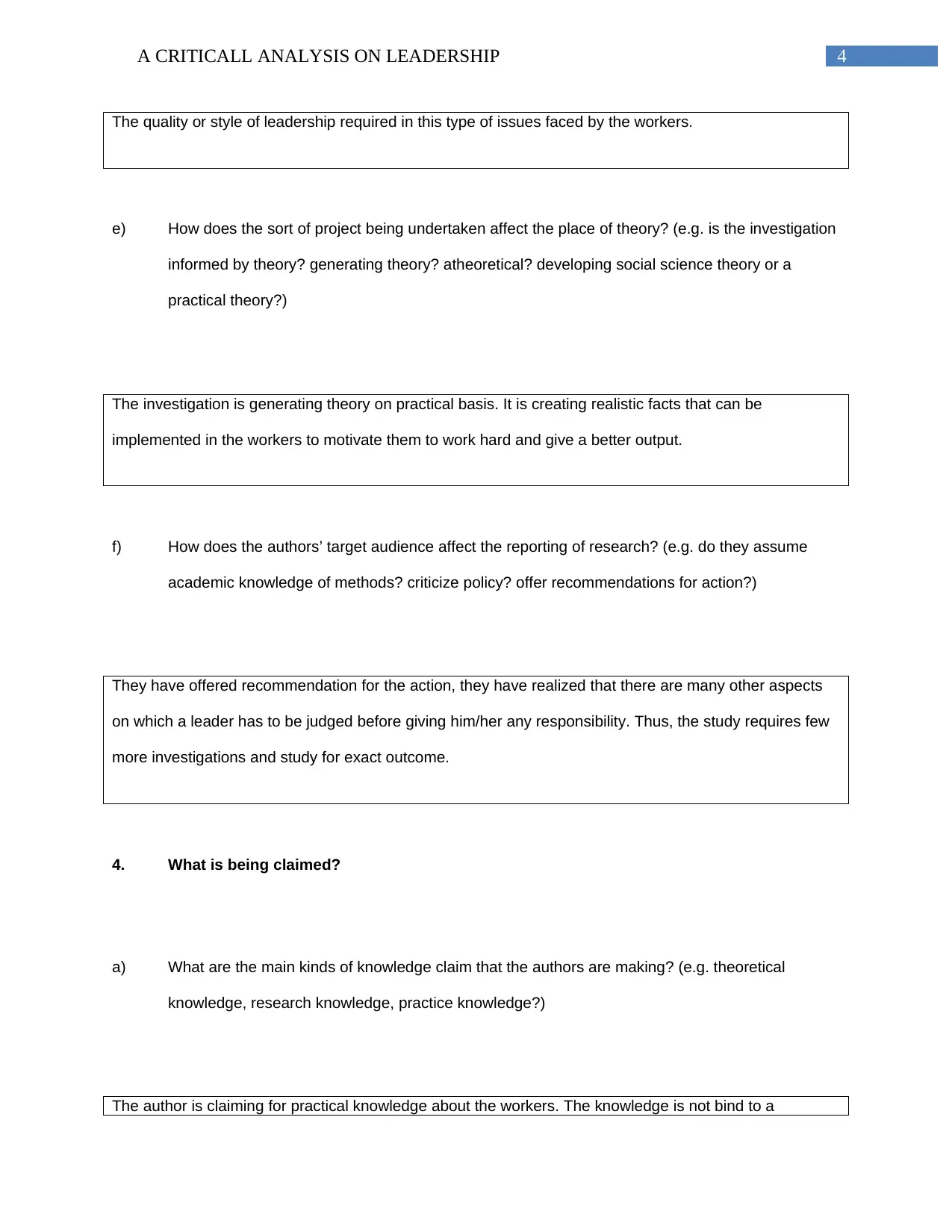
4A CRITICALL ANALYSIS ON LEADERSHIP
The quality or style of leadership required in this type of issues faced by the workers.
e) How does the sort of project being undertaken affect the place of theory? (e.g. is the investigation
informed by theory? generating theory? atheoretical? developing social science theory or a
practical theory?)
The investigation is generating theory on practical basis. It is creating realistic facts that can be
implemented in the workers to motivate them to work hard and give a better output.
f) How does the authors’ target audience affect the reporting of research? (e.g. do they assume
academic knowledge of methods? criticize policy? offer recommendations for action?)
They have offered recommendation for the action, they have realized that there are many other aspects
on which a leader has to be judged before giving him/her any responsibility. Thus, the study requires few
more investigations and study for exact outcome.
4. What is being claimed?
a) What are the main kinds of knowledge claim that the authors are making? (e.g. theoretical
knowledge, research knowledge, practice knowledge?)
The author is claiming for practical knowledge about the workers. The knowledge is not bind to a
The quality or style of leadership required in this type of issues faced by the workers.
e) How does the sort of project being undertaken affect the place of theory? (e.g. is the investigation
informed by theory? generating theory? atheoretical? developing social science theory or a
practical theory?)
The investigation is generating theory on practical basis. It is creating realistic facts that can be
implemented in the workers to motivate them to work hard and give a better output.
f) How does the authors’ target audience affect the reporting of research? (e.g. do they assume
academic knowledge of methods? criticize policy? offer recommendations for action?)
They have offered recommendation for the action, they have realized that there are many other aspects
on which a leader has to be judged before giving him/her any responsibility. Thus, the study requires few
more investigations and study for exact outcome.
4. What is being claimed?
a) What are the main kinds of knowledge claim that the authors are making? (e.g. theoretical
knowledge, research knowledge, practice knowledge?)
The author is claiming for practical knowledge about the workers. The knowledge is not bind to a
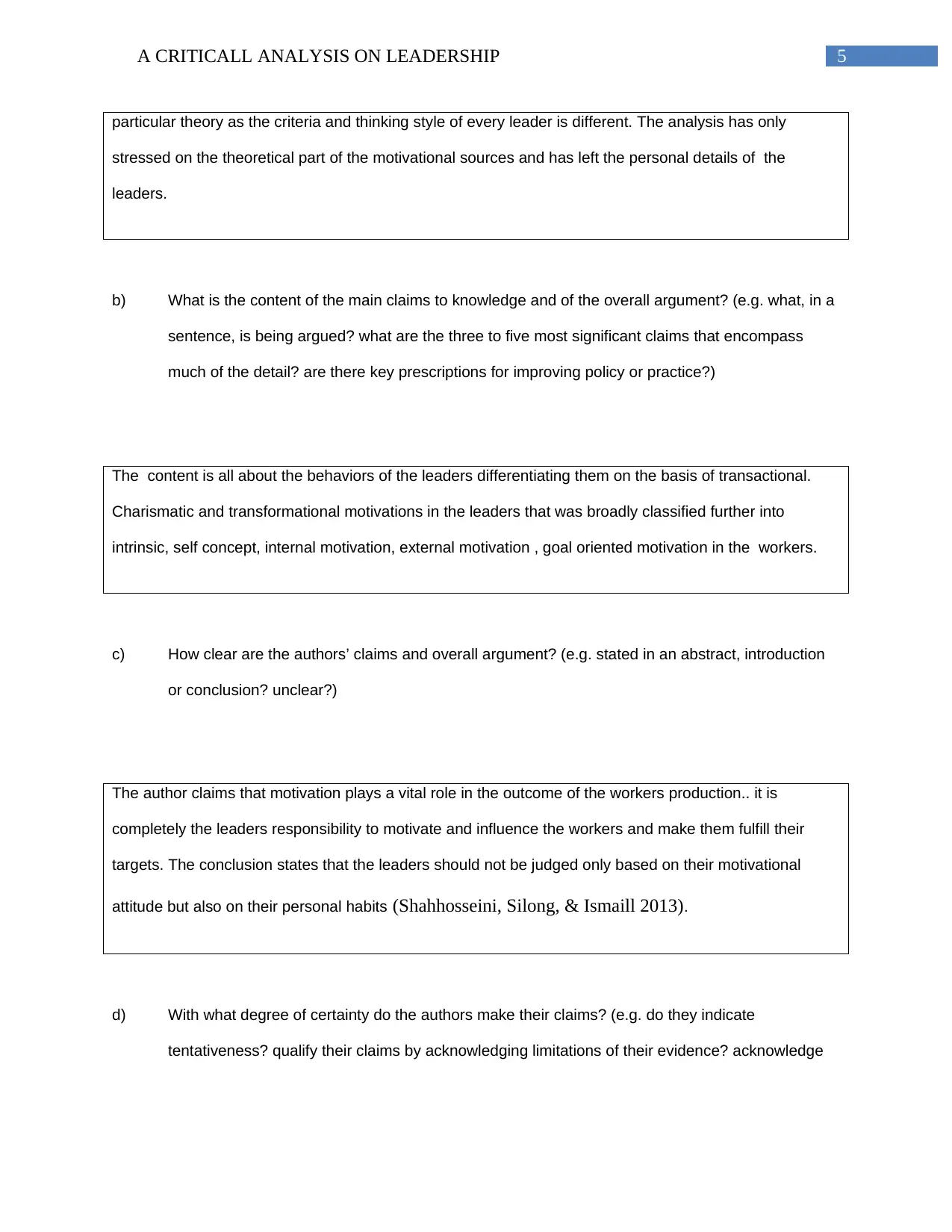
5A CRITICALL ANALYSIS ON LEADERSHIP
particular theory as the criteria and thinking style of every leader is different. The analysis has only
stressed on the theoretical part of the motivational sources and has left the personal details of the
leaders.
b) What is the content of the main claims to knowledge and of the overall argument? (e.g. what, in a
sentence, is being argued? what are the three to five most significant claims that encompass
much of the detail? are there key prescriptions for improving policy or practice?)
The content is all about the behaviors of the leaders differentiating them on the basis of transactional.
Charismatic and transformational motivations in the leaders that was broadly classified further into
intrinsic, self concept, internal motivation, external motivation , goal oriented motivation in the workers.
c) How clear are the authors’ claims and overall argument? (e.g. stated in an abstract, introduction
or conclusion? unclear?)
The author claims that motivation plays a vital role in the outcome of the workers production.. it is
completely the leaders responsibility to motivate and influence the workers and make them fulfill their
targets. The conclusion states that the leaders should not be judged only based on their motivational
attitude but also on their personal habits (Shahhosseini, Silong, & Ismaill 2013).
d) With what degree of certainty do the authors make their claims? (e.g. do they indicate
tentativeness? qualify their claims by acknowledging limitations of their evidence? acknowledge
particular theory as the criteria and thinking style of every leader is different. The analysis has only
stressed on the theoretical part of the motivational sources and has left the personal details of the
leaders.
b) What is the content of the main claims to knowledge and of the overall argument? (e.g. what, in a
sentence, is being argued? what are the three to five most significant claims that encompass
much of the detail? are there key prescriptions for improving policy or practice?)
The content is all about the behaviors of the leaders differentiating them on the basis of transactional.
Charismatic and transformational motivations in the leaders that was broadly classified further into
intrinsic, self concept, internal motivation, external motivation , goal oriented motivation in the workers.
c) How clear are the authors’ claims and overall argument? (e.g. stated in an abstract, introduction
or conclusion? unclear?)
The author claims that motivation plays a vital role in the outcome of the workers production.. it is
completely the leaders responsibility to motivate and influence the workers and make them fulfill their
targets. The conclusion states that the leaders should not be judged only based on their motivational
attitude but also on their personal habits (Shahhosseini, Silong, & Ismaill 2013).
d) With what degree of certainty do the authors make their claims? (e.g. do they indicate
tentativeness? qualify their claims by acknowledging limitations of their evidence? acknowledge
⊘ This is a preview!⊘
Do you want full access?
Subscribe today to unlock all pages.

Trusted by 1+ million students worldwide
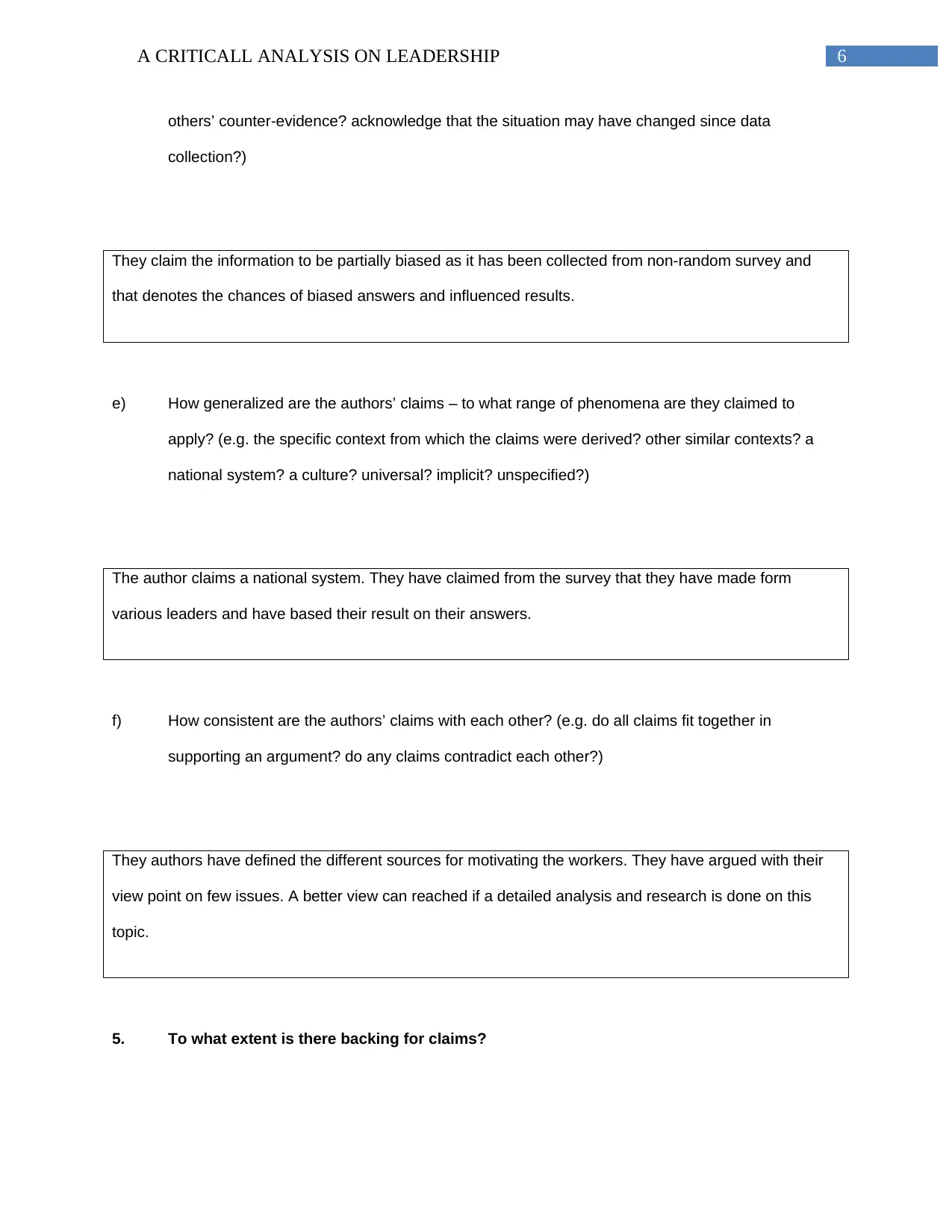
6A CRITICALL ANALYSIS ON LEADERSHIP
others’ counter-evidence? acknowledge that the situation may have changed since data
collection?)
They claim the information to be partially biased as it has been collected from non-random survey and
that denotes the chances of biased answers and influenced results.
e) How generalized are the authors’ claims – to what range of phenomena are they claimed to
apply? (e.g. the specific context from which the claims were derived? other similar contexts? a
national system? a culture? universal? implicit? unspecified?)
The author claims a national system. They have claimed from the survey that they have made form
various leaders and have based their result on their answers.
f) How consistent are the authors’ claims with each other? (e.g. do all claims fit together in
supporting an argument? do any claims contradict each other?)
They authors have defined the different sources for motivating the workers. They have argued with their
view point on few issues. A better view can reached if a detailed analysis and research is done on this
topic.
5. To what extent is there backing for claims?
others’ counter-evidence? acknowledge that the situation may have changed since data
collection?)
They claim the information to be partially biased as it has been collected from non-random survey and
that denotes the chances of biased answers and influenced results.
e) How generalized are the authors’ claims – to what range of phenomena are they claimed to
apply? (e.g. the specific context from which the claims were derived? other similar contexts? a
national system? a culture? universal? implicit? unspecified?)
The author claims a national system. They have claimed from the survey that they have made form
various leaders and have based their result on their answers.
f) How consistent are the authors’ claims with each other? (e.g. do all claims fit together in
supporting an argument? do any claims contradict each other?)
They authors have defined the different sources for motivating the workers. They have argued with their
view point on few issues. A better view can reached if a detailed analysis and research is done on this
topic.
5. To what extent is there backing for claims?
Paraphrase This Document
Need a fresh take? Get an instant paraphrase of this document with our AI Paraphraser
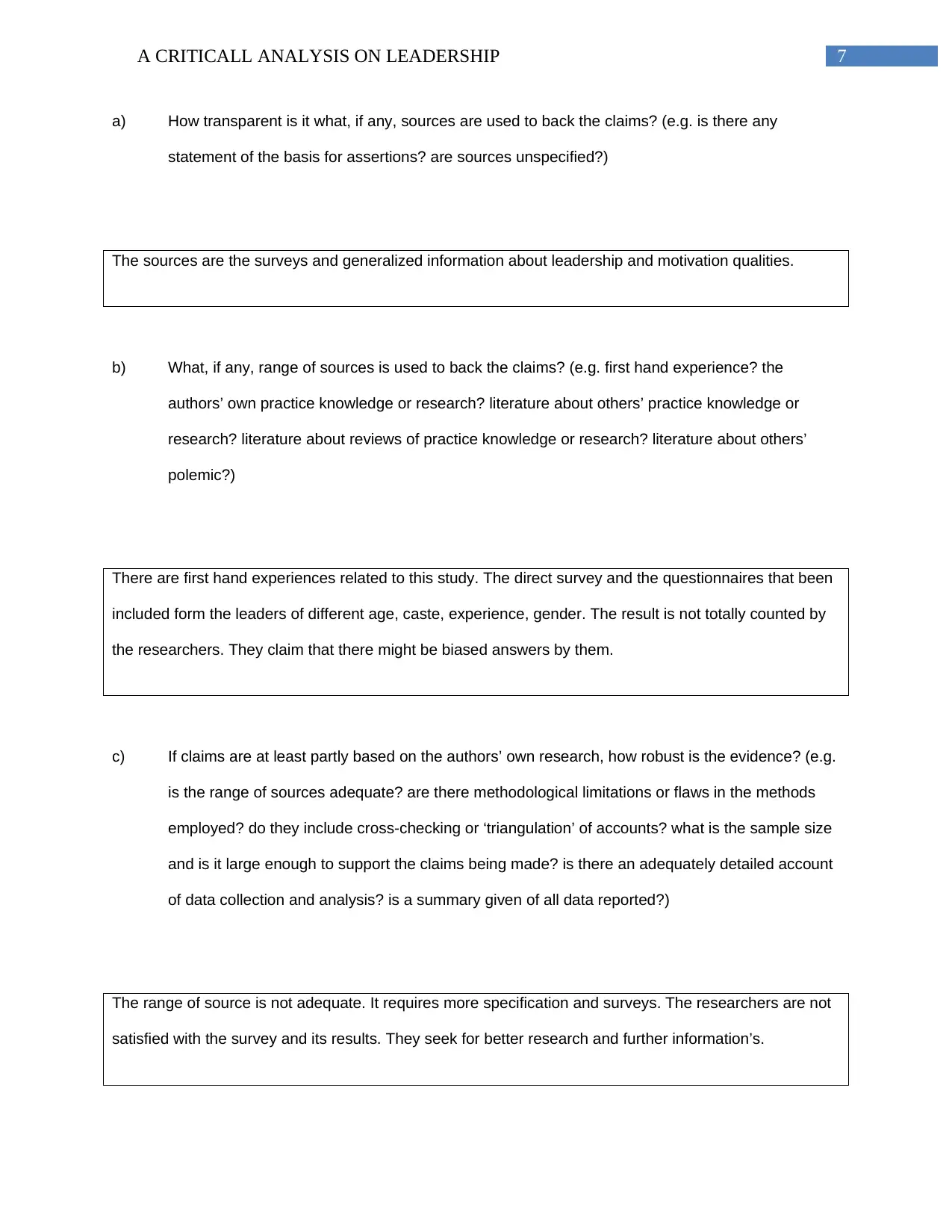
7A CRITICALL ANALYSIS ON LEADERSHIP
a) How transparent is it what, if any, sources are used to back the claims? (e.g. is there any
statement of the basis for assertions? are sources unspecified?)
The sources are the surveys and generalized information about leadership and motivation qualities.
b) What, if any, range of sources is used to back the claims? (e.g. first hand experience? the
authors’ own practice knowledge or research? literature about others’ practice knowledge or
research? literature about reviews of practice knowledge or research? literature about others’
polemic?)
There are first hand experiences related to this study. The direct survey and the questionnaires that been
included form the leaders of different age, caste, experience, gender. The result is not totally counted by
the researchers. They claim that there might be biased answers by them.
c) If claims are at least partly based on the authors’ own research, how robust is the evidence? (e.g.
is the range of sources adequate? are there methodological limitations or flaws in the methods
employed? do they include cross-checking or ‘triangulation’ of accounts? what is the sample size
and is it large enough to support the claims being made? is there an adequately detailed account
of data collection and analysis? is a summary given of all data reported?)
The range of source is not adequate. It requires more specification and surveys. The researchers are not
satisfied with the survey and its results. They seek for better research and further information’s.
a) How transparent is it what, if any, sources are used to back the claims? (e.g. is there any
statement of the basis for assertions? are sources unspecified?)
The sources are the surveys and generalized information about leadership and motivation qualities.
b) What, if any, range of sources is used to back the claims? (e.g. first hand experience? the
authors’ own practice knowledge or research? literature about others’ practice knowledge or
research? literature about reviews of practice knowledge or research? literature about others’
polemic?)
There are first hand experiences related to this study. The direct survey and the questionnaires that been
included form the leaders of different age, caste, experience, gender. The result is not totally counted by
the researchers. They claim that there might be biased answers by them.
c) If claims are at least partly based on the authors’ own research, how robust is the evidence? (e.g.
is the range of sources adequate? are there methodological limitations or flaws in the methods
employed? do they include cross-checking or ‘triangulation’ of accounts? what is the sample size
and is it large enough to support the claims being made? is there an adequately detailed account
of data collection and analysis? is a summary given of all data reported?)
The range of source is not adequate. It requires more specification and surveys. The researchers are not
satisfied with the survey and its results. They seek for better research and further information’s.
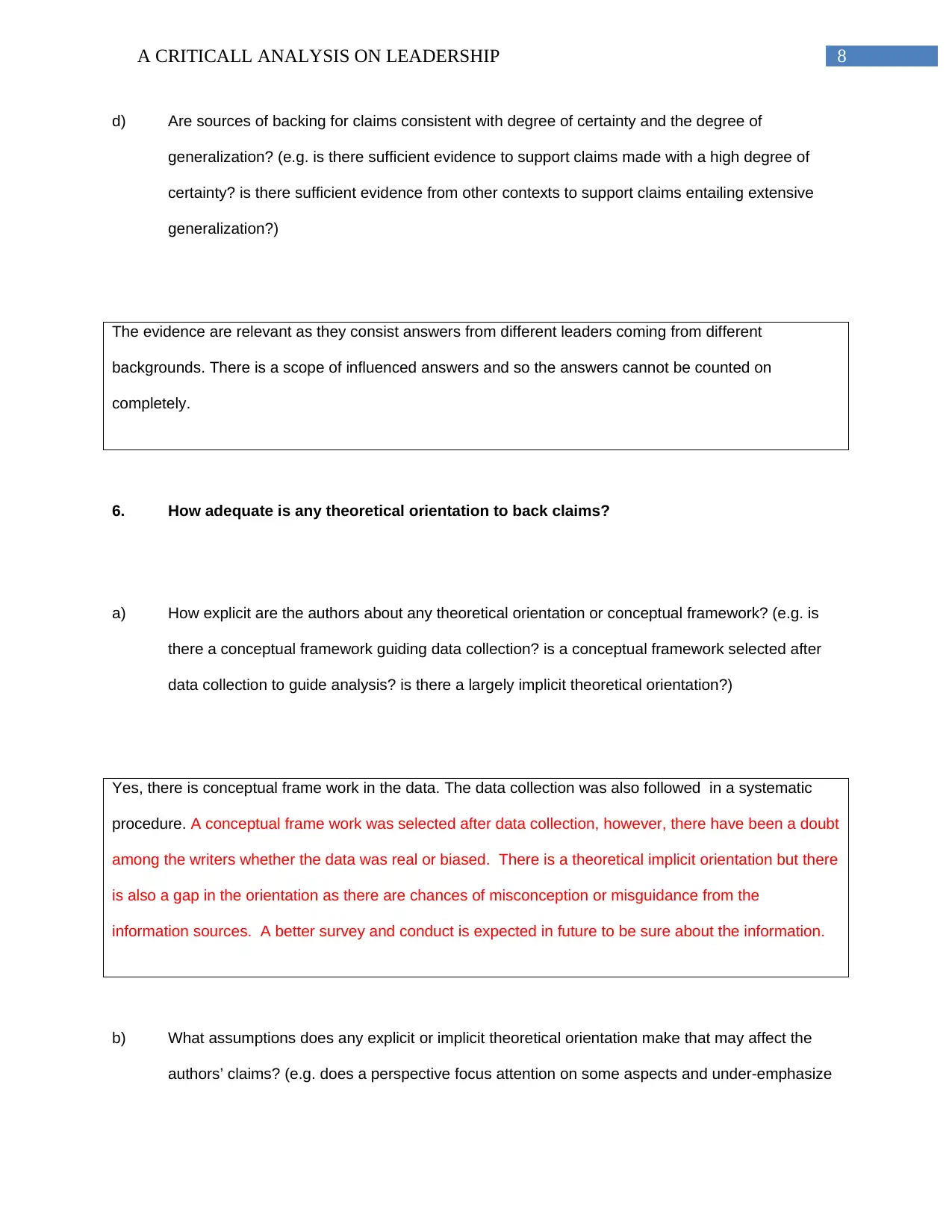
8A CRITICALL ANALYSIS ON LEADERSHIP
d) Are sources of backing for claims consistent with degree of certainty and the degree of
generalization? (e.g. is there sufficient evidence to support claims made with a high degree of
certainty? is there sufficient evidence from other contexts to support claims entailing extensive
generalization?)
The evidence are relevant as they consist answers from different leaders coming from different
backgrounds. There is a scope of influenced answers and so the answers cannot be counted on
completely.
6. How adequate is any theoretical orientation to back claims?
a) How explicit are the authors about any theoretical orientation or conceptual framework? (e.g. is
there a conceptual framework guiding data collection? is a conceptual framework selected after
data collection to guide analysis? is there a largely implicit theoretical orientation?)
Yes, there is conceptual frame work in the data. The data collection was also followed in a systematic
procedure. A conceptual frame work was selected after data collection, however, there have been a doubt
among the writers whether the data was real or biased. There is a theoretical implicit orientation but there
is also a gap in the orientation as there are chances of misconception or misguidance from the
information sources. A better survey and conduct is expected in future to be sure about the information.
b) What assumptions does any explicit or implicit theoretical orientation make that may affect the
authors’ claims? (e.g. does a perspective focus attention on some aspects and under-emphasize
d) Are sources of backing for claims consistent with degree of certainty and the degree of
generalization? (e.g. is there sufficient evidence to support claims made with a high degree of
certainty? is there sufficient evidence from other contexts to support claims entailing extensive
generalization?)
The evidence are relevant as they consist answers from different leaders coming from different
backgrounds. There is a scope of influenced answers and so the answers cannot be counted on
completely.
6. How adequate is any theoretical orientation to back claims?
a) How explicit are the authors about any theoretical orientation or conceptual framework? (e.g. is
there a conceptual framework guiding data collection? is a conceptual framework selected after
data collection to guide analysis? is there a largely implicit theoretical orientation?)
Yes, there is conceptual frame work in the data. The data collection was also followed in a systematic
procedure. A conceptual frame work was selected after data collection, however, there have been a doubt
among the writers whether the data was real or biased. There is a theoretical implicit orientation but there
is also a gap in the orientation as there are chances of misconception or misguidance from the
information sources. A better survey and conduct is expected in future to be sure about the information.
b) What assumptions does any explicit or implicit theoretical orientation make that may affect the
authors’ claims? (e.g. does a perspective focus attention on some aspects and under-emphasize
⊘ This is a preview!⊘
Do you want full access?
Subscribe today to unlock all pages.

Trusted by 1+ million students worldwide
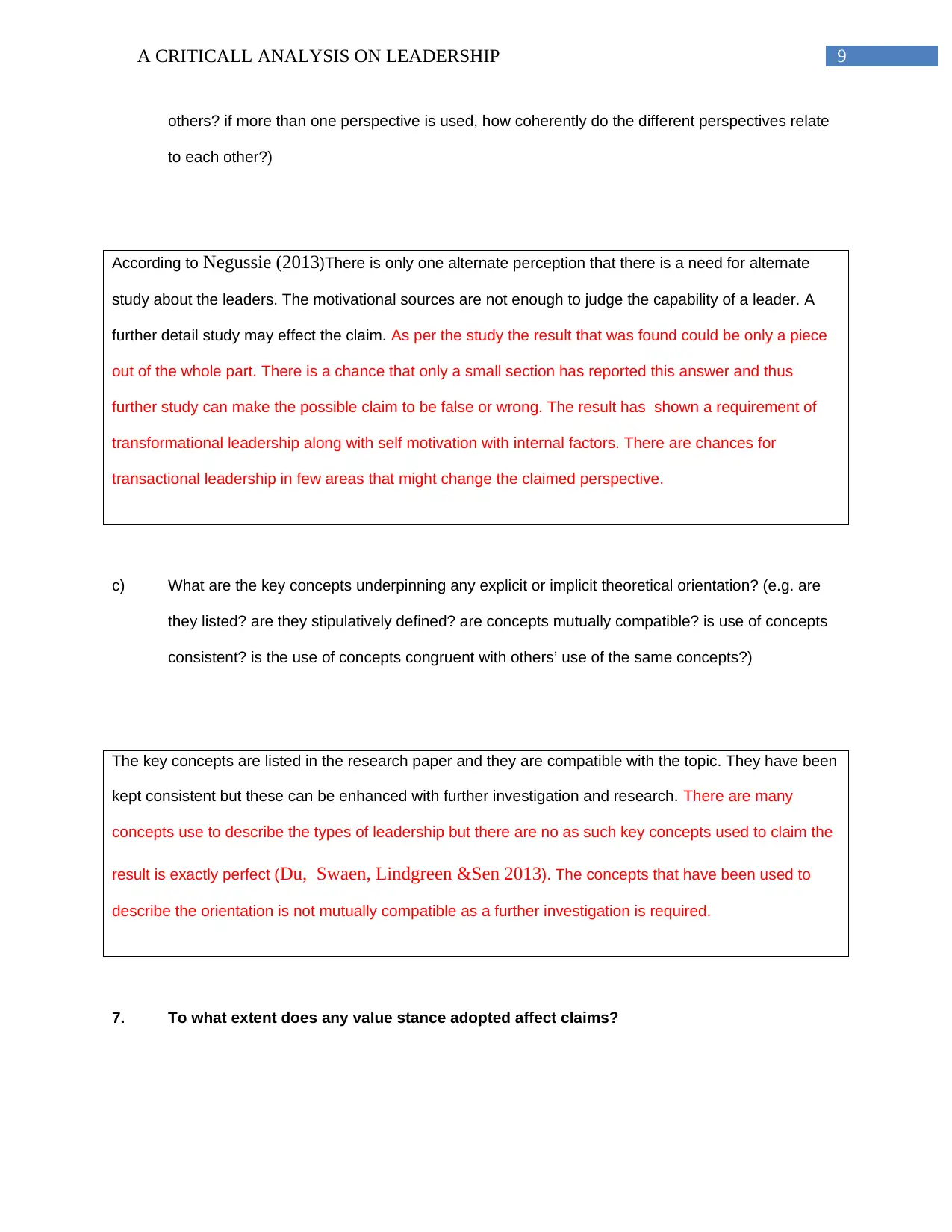
9A CRITICALL ANALYSIS ON LEADERSHIP
others? if more than one perspective is used, how coherently do the different perspectives relate
to each other?)
According to Negussie (2013)There is only one alternate perception that there is a need for alternate
study about the leaders. The motivational sources are not enough to judge the capability of a leader. A
further detail study may effect the claim. As per the study the result that was found could be only a piece
out of the whole part. There is a chance that only a small section has reported this answer and thus
further study can make the possible claim to be false or wrong. The result has shown a requirement of
transformational leadership along with self motivation with internal factors. There are chances for
transactional leadership in few areas that might change the claimed perspective.
c) What are the key concepts underpinning any explicit or implicit theoretical orientation? (e.g. are
they listed? are they stipulatively defined? are concepts mutually compatible? is use of concepts
consistent? is the use of concepts congruent with others’ use of the same concepts?)
The key concepts are listed in the research paper and they are compatible with the topic. They have been
kept consistent but these can be enhanced with further investigation and research. There are many
concepts use to describe the types of leadership but there are no as such key concepts used to claim the
result is exactly perfect (Du, Swaen, Lindgreen &Sen 2013). The concepts that have been used to
describe the orientation is not mutually compatible as a further investigation is required.
7. To what extent does any value stance adopted affect claims?
others? if more than one perspective is used, how coherently do the different perspectives relate
to each other?)
According to Negussie (2013)There is only one alternate perception that there is a need for alternate
study about the leaders. The motivational sources are not enough to judge the capability of a leader. A
further detail study may effect the claim. As per the study the result that was found could be only a piece
out of the whole part. There is a chance that only a small section has reported this answer and thus
further study can make the possible claim to be false or wrong. The result has shown a requirement of
transformational leadership along with self motivation with internal factors. There are chances for
transactional leadership in few areas that might change the claimed perspective.
c) What are the key concepts underpinning any explicit or implicit theoretical orientation? (e.g. are
they listed? are they stipulatively defined? are concepts mutually compatible? is use of concepts
consistent? is the use of concepts congruent with others’ use of the same concepts?)
The key concepts are listed in the research paper and they are compatible with the topic. They have been
kept consistent but these can be enhanced with further investigation and research. There are many
concepts use to describe the types of leadership but there are no as such key concepts used to claim the
result is exactly perfect (Du, Swaen, Lindgreen &Sen 2013). The concepts that have been used to
describe the orientation is not mutually compatible as a further investigation is required.
7. To what extent does any value stance adopted affect claims?
Paraphrase This Document
Need a fresh take? Get an instant paraphrase of this document with our AI Paraphraser
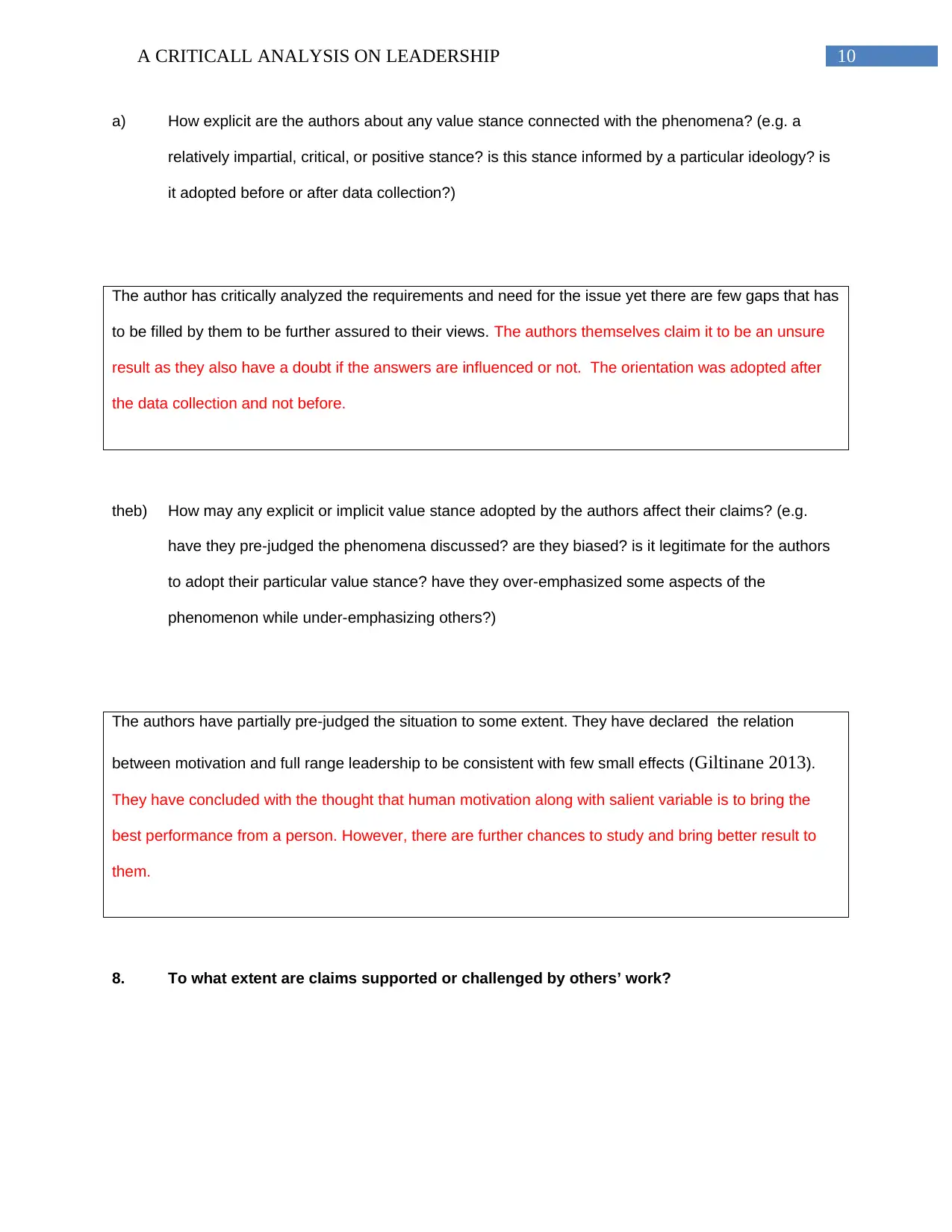
10A CRITICALL ANALYSIS ON LEADERSHIP
a) How explicit are the authors about any value stance connected with the phenomena? (e.g. a
relatively impartial, critical, or positive stance? is this stance informed by a particular ideology? is
it adopted before or after data collection?)
The author has critically analyzed the requirements and need for the issue yet there are few gaps that has
to be filled by them to be further assured to their views. The authors themselves claim it to be an unsure
result as they also have a doubt if the answers are influenced or not. The orientation was adopted after
the data collection and not before.
theb) How may any explicit or implicit value stance adopted by the authors affect their claims? (e.g.
have they pre-judged the phenomena discussed? are they biased? is it legitimate for the authors
to adopt their particular value stance? have they over-emphasized some aspects of the
phenomenon while under-emphasizing others?)
The authors have partially pre-judged the situation to some extent. They have declared the relation
between motivation and full range leadership to be consistent with few small effects (Giltinane 2013).
They have concluded with the thought that human motivation along with salient variable is to bring the
best performance from a person. However, there are further chances to study and bring better result to
them.
8. To what extent are claims supported or challenged by others’ work?
a) How explicit are the authors about any value stance connected with the phenomena? (e.g. a
relatively impartial, critical, or positive stance? is this stance informed by a particular ideology? is
it adopted before or after data collection?)
The author has critically analyzed the requirements and need for the issue yet there are few gaps that has
to be filled by them to be further assured to their views. The authors themselves claim it to be an unsure
result as they also have a doubt if the answers are influenced or not. The orientation was adopted after
the data collection and not before.
theb) How may any explicit or implicit value stance adopted by the authors affect their claims? (e.g.
have they pre-judged the phenomena discussed? are they biased? is it legitimate for the authors
to adopt their particular value stance? have they over-emphasized some aspects of the
phenomenon while under-emphasizing others?)
The authors have partially pre-judged the situation to some extent. They have declared the relation
between motivation and full range leadership to be consistent with few small effects (Giltinane 2013).
They have concluded with the thought that human motivation along with salient variable is to bring the
best performance from a person. However, there are further chances to study and bring better result to
them.
8. To what extent are claims supported or challenged by others’ work?
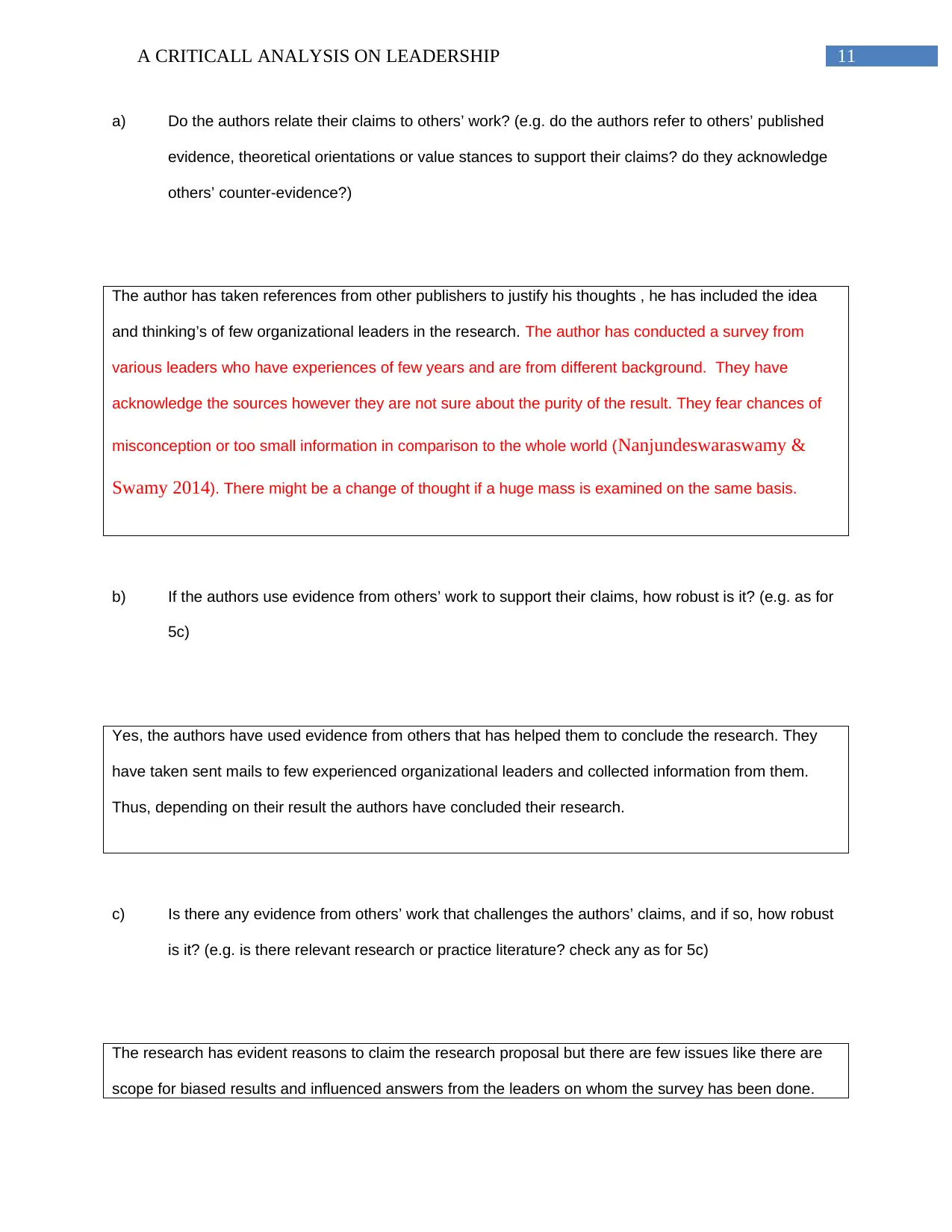
11A CRITICALL ANALYSIS ON LEADERSHIP
a) Do the authors relate their claims to others’ work? (e.g. do the authors refer to others’ published
evidence, theoretical orientations or value stances to support their claims? do they acknowledge
others’ counter-evidence?)
The author has taken references from other publishers to justify his thoughts , he has included the idea
and thinking’s of few organizational leaders in the research. The author has conducted a survey from
various leaders who have experiences of few years and are from different background. They have
acknowledge the sources however they are not sure about the purity of the result. They fear chances of
misconception or too small information in comparison to the whole world (Nanjundeswaraswamy &
Swamy 2014). There might be a change of thought if a huge mass is examined on the same basis.
b) If the authors use evidence from others’ work to support their claims, how robust is it? (e.g. as for
5c)
Yes, the authors have used evidence from others that has helped them to conclude the research. They
have taken sent mails to few experienced organizational leaders and collected information from them.
Thus, depending on their result the authors have concluded their research.
c) Is there any evidence from others’ work that challenges the authors’ claims, and if so, how robust
is it? (e.g. is there relevant research or practice literature? check any as for 5c)
The research has evident reasons to claim the research proposal but there are few issues like there are
scope for biased results and influenced answers from the leaders on whom the survey has been done.
a) Do the authors relate their claims to others’ work? (e.g. do the authors refer to others’ published
evidence, theoretical orientations or value stances to support their claims? do they acknowledge
others’ counter-evidence?)
The author has taken references from other publishers to justify his thoughts , he has included the idea
and thinking’s of few organizational leaders in the research. The author has conducted a survey from
various leaders who have experiences of few years and are from different background. They have
acknowledge the sources however they are not sure about the purity of the result. They fear chances of
misconception or too small information in comparison to the whole world (Nanjundeswaraswamy &
Swamy 2014). There might be a change of thought if a huge mass is examined on the same basis.
b) If the authors use evidence from others’ work to support their claims, how robust is it? (e.g. as for
5c)
Yes, the authors have used evidence from others that has helped them to conclude the research. They
have taken sent mails to few experienced organizational leaders and collected information from them.
Thus, depending on their result the authors have concluded their research.
c) Is there any evidence from others’ work that challenges the authors’ claims, and if so, how robust
is it? (e.g. is there relevant research or practice literature? check any as for 5c)
The research has evident reasons to claim the research proposal but there are few issues like there are
scope for biased results and influenced answers from the leaders on whom the survey has been done.
⊘ This is a preview!⊘
Do you want full access?
Subscribe today to unlock all pages.

Trusted by 1+ million students worldwide
1 out of 15
Related Documents
Your All-in-One AI-Powered Toolkit for Academic Success.
+13062052269
info@desklib.com
Available 24*7 on WhatsApp / Email
![[object Object]](/_next/static/media/star-bottom.7253800d.svg)
Unlock your academic potential
Copyright © 2020–2025 A2Z Services. All Rights Reserved. Developed and managed by ZUCOL.



